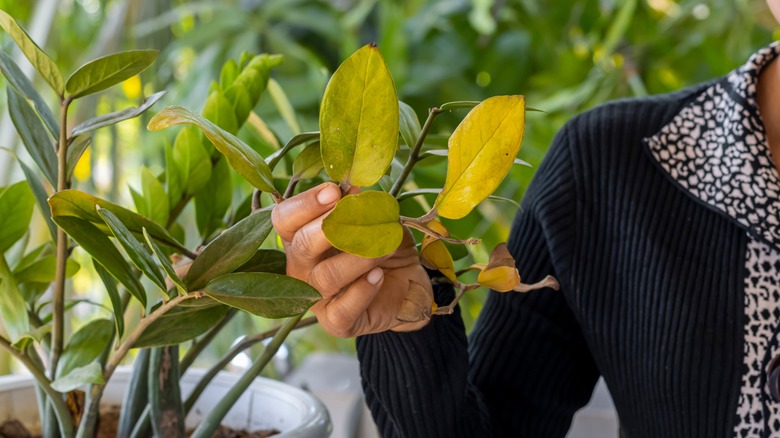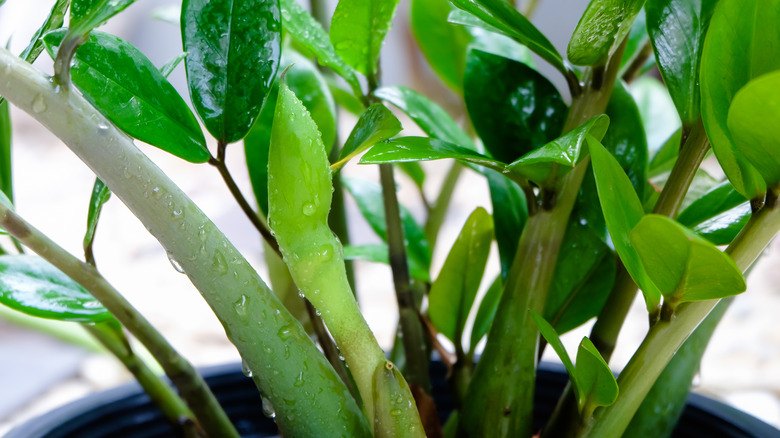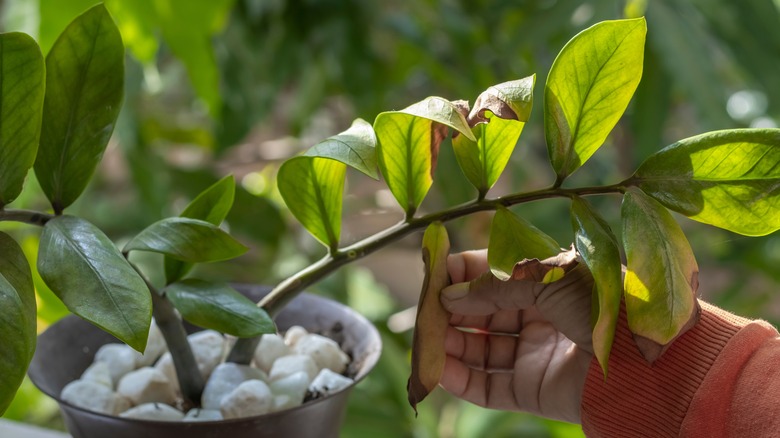Here's The Number 1 Reason ZZ Plants Turn Yellow & What You Can Do About It
Most new plant parents start out with the ZZ plant, more formally known as the Zamioculcas zamiifolia, because of their reputation for being easy to care for and forgiving of neglect. They're native to southeastern Africa, where the forests have dry and sandy soils, and there is little sunlight exposure on the forest floor. It's no wonder ZZ plants can tolerate such little sunlight and water.
Low maintenance doesn't mean there will be zero maintenance, so you might come across the occasional yellow leaf if your plant is unhappy with how it's being treated. Fortunately, most issues can be corrected to prevent the plant from dying, so you don't need to worry about losing the entire plant unless it's a sudden and severe case. When it comes to ZZ plant problems, the culprit is most likely related to water or sunlight, as these can be the trickiest parts to get just right.
Moisture problems are the main cause of yellowing leaves
Though there could be several causes of your ZZ plant starting to turn yellow, moisture is typically the most common reason. Plenty of plant owners have plants because they enjoy taking care of them; if that sounds like you, ZZ plants may be difficult to care for because of how little care they really need. Their roots have rhizomes that store water to prepare for dry seasons, and their waxy leaves prevent moisture from escaping during the day. Because of these nifty adaptations that allow them to thrive in their native habitat outdoors, you barely need to water them, and should only do so once their soil is completely dry.
ZZ plants will turn yellow when thirsty and progress to brittle and brown if neglected. They can also start out with yellow patches when they're overwatered, but they'll quickly turn brown and mushy. If you're not sure what your plant is experiencing, stick your finger into the soil. If it's bone dry, it's time for a drink, and if it's wet, it's time to repot the plant into drier soil.
Pests that suck sap out of plants, like aphids and spider mites, may also cause moisture damage to your ZZ plant. This damage can reveal itself as yellow spots on the leaves. Look for the pests on the undersides of damaged leaves, as they often like to hide there. Spider mites will also be accompanied by fine white webbing.
Other reasons your ZZ plant might be turning yellow
Perhaps the second most common issue is sun exposure. This plant commonly requires very little sunlight, although it can do quite well under fluorescent lights in offices. Too much or too little sunlight can result in brown leaves that start out yellow. Direct light can burn the leaves, so if you live in a hot climate where they can grow outside, be sure to keep them in a shaded area.
Inconsistent care can also lead to a stressed out ZZ plant, which often displays its symptoms as yellow leaves. Make sure you consistently give it the same amount of sunlight and water on a somewhat set schedule. Allowing the plant to go too long without water and then flooding it will stress it out, as will keeping it in the dark, then moving it to a bright room, then moving it back to the dark.
Too much fertilizer is another reason your ZZ plant may be unhappy. They only need to be fertilized once or twice each year. ZZ plants grow incredibly slow, and while increasing fertilizer may help it grow a little faster, you're ultimately risking overdoing it. If your plant develops yellow leaves after fertilizing it, that means it's time to give it a break for a while.


